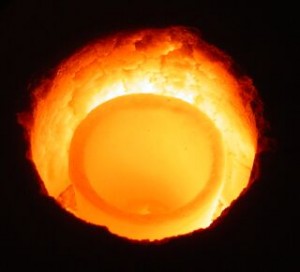|
|
Online Texts for Craig White's Literature Courses
|
|
|
Emily Dickinson Selected Poetry [Dare you see a Soul at the White Heat?] Dickinson style sheet Poe, Dickinson, Whitman styles compared |
|
|
Questions: 1. Dickinson's poetry may seem to operate in some timeless realm, but how may it reflect its time-period of late Romanticism, bordering on early Realism? 2. What characteristics of style indicate this is a poem by Emily Dickinson? How does a reader manage her free use of dashes? 3. Compare this poem's form as "free verse" or "formal verse" with poems by Poe and Whitman (and other poems by Dickinson). 4. What is an extended metaphor? What is the extended metaphor in this poem? What are the attractions or aesthetics of extended metaphor? 4a. What are the historic limits of metaphor? For instance, in the poem below, "a Soul" is represented by reference to a forge, i.e. a contained fire for heating and shaping metals. (See images at side and below.) 4b. The referent of forges is now outside most people's practical knowledge or experience, but how may the metaphor still apply to the concept of "a Soul?" |
|
![]()
[1]
Dare you see a Soul at the White Heat?
[2]
Then crouch within the door—
[3]
Red—is the Fire's common tint—
[4]
But when the vivid Ore
[5]
Has vanquished Flame's conditions,
[6]
It quivers from the Forge
[forge = blacksmith's apparatus for heating and
shaping metals]
[7]
Without a color, but the light
[8]
Of unanointed Blaze.
[unanointed = unsanctified]
[9]
Least Village has its Blacksmith
[Least Village = the smallest village]]
[10]
Whose Anvil's even ring
[11]
Stands symbol for the finer Forge
[12]
That soundless tugs—within—
[correspondence?]
[13]
Refining these impatient Ores
[14]
With hammer, and with Blaze
[15]
Until the Designated Light
[16]
Repudiate the Forge—
![]()
Images of Forges
|
|
|
 |
 |

thanks to
http://dannmay.com/archives/projects/kings-forge





